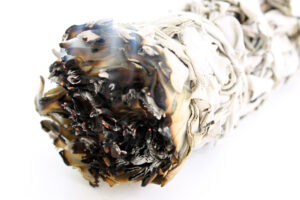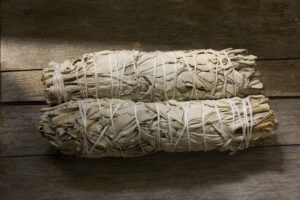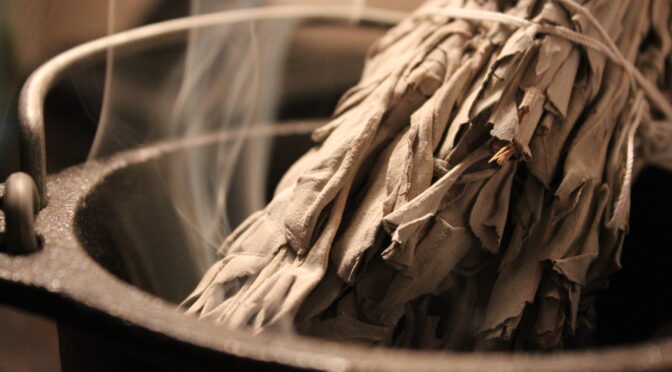The practice of smudging dates back to prehistoric times, and is still very much in use today worldwide for cleansing everything from dwellings to human spirits. However recent research has shed light on the popularity of this activity, revealing that burning certain plant matter actually clears harmful bacteria.
All Western use of burning herbs and plants for spiritual purposes aside, the activity rests firmly in the sensibilities of ancient cultures in that, historically, smudging was believed to put forth the spirits of various ‘allies’ to provide ease and balance to an individual or group.
In this way, the practice was used to clear spiritual and emotional negativity that has built up in a body or a space.
Of course, there are skeptics who belittle the practice as unscientific and akin to magic.
The practice has a negative association to a form of cultural imperialism, where traditions of dwindling indigenous populations are co-opted by the descendants of those who more-or-less conquered them.
The scientific paper entitled “Medicinal Smokes” and published in the Journal of Ethnopharmacology focuses a scientific lens on the practice, which is becoming more and more widely practiced, despite skepticism.
It serves to play against the role that this activity has played in a culturally diverse range of religions and tribal beliefs.
The research study looked into herbal and non-herbal remedies that were administered by the burning of various matter.
The research included information from 50 countries over 5 continents and found that, predominantly, smoke administered medicinally is mostly used to aid lung, brain and skin function. In addition, it was revealed that passive fumes doubled as a sort of air purifier.
The purpose of the study was to see whether or not these medicinal smoke deliveries could be explored by western medicine, because “The advantages of smoke-based remedies are rapid delivery to the brain, more efficient absorption by the body and lower costs of production.”
A follow up paper published in the same periodical, “Medicinal smoke reduces airborne bacteria,” found that the research concluded that, in addition to health benefits, smudging was a powerful antiseptic.

“We have observed that 1 hour treatment of medicinal smoke emanated by burning wood and a mixture of odoriferous and medicinal herbs (havan sámagri=material used in oblation to fire all over India), on aerial bacterial population caused over 94% reduction of bacterial counts by 60 min and the ability of the smoke to purify or disinfect the air and to make the environment cleaner was maintained up to 24 hour in the closed room.
Absence of pathogenic bacteria Corynebacterium urealyticum, Curtobacterium flaccumfaciens, Enterobacter aerogenes (Klebsiella mobilis), Kocuria rosea, Pseudomonas syringae pv. persicae, Staphylococcus lentus, and Xanthomonas campestris pv. tardicrescens in the open room even after 30 days is indicative of the bactericidal potential of the medicinal smoke treatment.
We have demonstrated that using medicinal smoke it is possible to completely eliminate diverse plant and human pathogenic bacteria of the air within confined space.”
In short, burning medicinal herbs cleared airborne bacterial populations by 94%, and the space was still found to be disinfected a day later. What’s more, a month after smudging, much of the pathogens originally found were still undetectable.
This has profound implications, as modern air quality in the developed and undeveloped world is atrocious, containing up to 1800 bacterial types, many of them pathogenic. With an increasing deadly array of antibacterial-resistant strains, we’ll need all the help we can get.
Conventional methods of sterilization often employ chemical cocktails that are typically much less effective than purported. Smudging seems to be an effective alternative, while also being natural and safe to use.
In conclusion, the ancient practice of burning powerful herbal material may be much much more than just a primitive belief that we can simply disregard due to it being unscientific.
Of course, this should not take away from the properties of smudging in the area of energy system and soul cleansing and in the power of aromatherapy.


Thanks Cheryl for posting all of this fascinating info. we will catch up soon. I always appreciate your wisdom ? ?B
?B
I just bought some spray white sage and cedar. I like.
The sage used in smudging is found growing in high desert areas in Washingon, Oregon, Nevada, Ca California, etc., the sage brush of the Old West. Not the garden sage you cook with. Some people also use lavender and other aromatic anti-bacterial herbs in smudging bundles.
How long at one time should you burn the sage?
I’m getting ready to Smudge a home tonight . I use white sage for cleansing. Then sea salt around the barrier of the home. As many as I do I’m about ready to grow my own.
Thanks you for sharing this great information. I will look into it, to get some, and I live in Oklahoma, so I will find a tribal store or ask my cousins who still live on the reservation. Thanks, again!
Thank you. I am in need of sage to purify my present living arrangements. I am going to look in to growing my own when I return home. It’s good to know that white sage does well in cold as I am in upstate NY.
I burn some every night before I go to bed cause it soothes me. Once a month I smoke the whole house jus to keep negative energy at bae. Ive also had ppl come into my home an said they feel at peace here as soon as they walk in. I like that. My home is an Oasis.
Frankincense and Myrrh resins are also very healing and like sage, have many wonderful properties!
I smudged my apartment with white sage on New Year’s Eve just before midnight. I wanted to start the year “clean”. Unfortunately, it set off our very sensitive smoke detector and the entire 36 apartment complex had to evacuate until the fire apartment arrived. 36 units, 1 am, 28 degrees outside. Happy New Year!
I found this way too funny … I apologize.
That’s funny! Thanks for sharing ?
I love loose white sage, sweet grass and palo santo. All wonderful herbs and sweetgrass tea is heavenly.
There are different types of sage even a Russian sage which can grow in diverse cold climates. It is easy to grow. It will take care of itself. I am Ojibwe from Northern Michigan in the U.S. and we use it spiritually but this a nice article to highlight the science of burning sage also. We call it smudging and I am going to get my bundle and smudging shell and burn some now. Good reminder and good information!
Usually does not thrive far from the ocean . Likes poor soil.
Very easy to grow. it’s drying too just make sure you’re not allergic open a window a bit or do just one room
Thanks for posting such an interesting article!
Where do you buy the sage at?
I don’t, but if you’d want to, you can buy sage online or at your local holistic shops. You could also grow it yourself! <3
Any particular variety to grow?
White sage. Personally, I like sweetgrass because it looks so pretty and it does well in cold weather.
White sage is zoned as zone 9 for planting so if you have cold winters you will have to bring it inside or have a greenhouse.
Also, spiritually, sage is used for clearing negative energies and sweetgrass is used for pulling positive energies into a space.
Me too.
There is more than one variety of “white sage” — in Northern Plains, i.e., Dakotas – there is “peji hota” (Lakota language) — it is a ubiquitous plant which grows wild everywhere. It is used wherever and whenever “sage” is needed — also is referred to as “white sage” although it is more of a silvery-gray colour, and a little darker on underside of leaves.
Most importantly, peji hota is NOT a true sage, but rather a type of mugwort! It is much stronger and more pungent in scent than “white sage” and is a kick-a$$ chaser for anything on any level that needs to be cleared.
Is also used exclusively in the “sage” tea that the Sundance ceremonial singers consume in order to keep their vocal endurance during the hours-and-and-long ceremony.
You can order through herb companies specifically located in these geographical areas — specify you want “Lakota sage.”
White sage
White sage.
Look up Growing California White Sage on Amazon. Great styff!
The ubiquitous “sage” (in Lakota “peji hota” ) used and grown in South Dakotas is actually a type of mugwort — NOT true sage. It is very different, and smells very different, from the “white sage” typically found in metaphysical stores etc. It is a true “kick-ass” in terms of power levels and is used exclusively by the Lakota in smudging… it grows wild everywhere there.
White is good
But then you gotta bundle and dry it totally.
It must be the white sage however, do not use common garden sage for this!
Amazon or just google it!
wholefoods
lol
Grow it yourself!
there is a website named shamanherbs.com i believe thats the name. or you can buy it fresh at any food store and dry it yourself
I sell them and harvest it myself. Small bundle is $3, larger $5 and large is $8. I just made up 130 small and large bundles .
Would it be possible to order from you?
Do you have a website?
Robin, what is procedure for purchasing sage do you have white sage?
I would like to know if you ship the sticks to Puerto Rico
Hi can I order through you?
I love the smell of white sage. The first time I ever smelled it was at a pow-wow. I bought some but never burned it. I would go smell it whenever I wanted to feel a pleasant, calmness. It worked every time. I have a feeling it lowered my blood pressure when I was stressed which has been most of the time for a while now. How long do you burn it for?
Photos? Pure sage? Or mixes?
Herb shops…Amazon has also
Shop at a local holistic store so you can support your local herb growers!:)
I grow mine. Totally worth it
What would I plant to grow it. I like sweet grass. Where do I find it??
Whole Foods
Best to get blessed smudge sticks that were collected after asking permission of the plant from native tribe stores.
Right people always take from native Americans to use for their own advantage to make money!
whole foods has it.
I sell it and ship..Very fresh and send a turkey feather with it..I also have tiny abalone shells to place your sage ?
?
You can buy White sage for smudging on Amazon.
I grow it.
I burn sage Everyday as I am Native American I usually get it from the Native store .But my car broke down so I ordered it up from Amazon same good quality maybe even better then the native store.I pray with it on a daily basis the smoke rises to send my prayers up to CREATOR ,when done with praying I go outside and offer tobacco to Creator to hear my prays and receive them.I FEEL SO GOOD AFTER.
.
You could try growing it yourself, it’s really easy to grow.
Sweet Medicine Shoppe
You can pick yr own and bind it with cotton into a stick. Burn when dried. Buy a bush and plant in the garden if you Can, developed a relationship with it as a healing plant. Otherwise buy smudge sticks online, but you don’t know if these are organic or sprayed with chemicLs
Health food store, Amazon
Natural Grocers carries a wide variety of sage sticks.
I use Triloka, the best in incense and smudging materials. Smudging, or the burning of incense/herbs- is an ancient practice commonly used to both purify the air and to encourage harmony. Palo Santo, or ” Holy Wood”- is my favorite. ?
Amazon has it
In any spiritual healing shop
White sage it’s either in small cut timbers or like a small bundle of white straw
You pick it. It’s usually ready by end of August or September.
Earthbound Trading company
Behind the at.
Any health food place
Buy it in the spice isle at your grocery store. It’s an herb used in cooking. Or you can buy the plants to grow it at most garden centers. It’s very easy to get.
Whole Foods sells it.
There are sellers on Ebay that sell it …its cheap but powerful.
Health Food Stores.
Whole Foods has some. If you can’t find it elsewhere.
Thanks so much for sharing……… very informative article! Light, life, love, and kindness to you.
????
The article is good, however the title is misleading. It does NOT tell HOW the smoke works, merely that it does. Still important but more work needed on how the phoytochemicals destroy bacteria. Also, does it work against viruses? Thanks.
It works.i had black mold in basement..I felt hopeless.i burned some sage..mold still there but dormant..u can feel and smell the difference..I’m a skeptic majority of times till convinced..and I can say ‘I believe in this ‘ by experience ????
Great news so glad I read this I have a bundle and I’ll bet it will help with my fatigue since tree went through my roof the air probably needs saged
Dehumidification, a refrigeration process which is inexpensive and uses no chemicals, will give complete remission of mold problems in your basement!
How exactly did you do this. My son has black mold in his basement, girlfriend had to move out cause she got very sick.
Negative ions.
Love this article! I linked to your article in a blog post I wrote about smudging here: https://www.julieannfae.com/single-post/SmudgeALittleSmudgeALot
Thanks for compiling all of this science info for us!
Thank you
“Co-opted,” or learned from, and learned to appreciate…and of course we often forget that smudging or saining was practiced by many European and Norse cultures.
It’s simple physics , read a book. And can someone please smudge that comment area up there
Thank you for this intelligent reply. I thought the same and wish we were more willing, as people in general, to share what our cultures have learned without feeling that we are being “co-opted”. Our entire compendium of learning and experience is one of cross-cultural sharing, as it should be.
Nice. Thank you.